2020 Annual Report for: Momphidae / Momphinae
For species seen in 2020 that had less than or equal to 100 records, full details are included; for more common species, the earliest, latest and highest count by vice-county are shown. The narrative for each species is taken from the main Hantsmoths website, and it is possible that some information on abundance and occurrence can get out of date, as it is impossible to keep up with all changes; however it should give a good introduction to each species. The tables in each species account summarise the previous status, and that for the current year.
For the maps, all records prior to 2020 are shown by a blue dot (the larger the dot, the more recent), with the current year's records shown in red. As previous records are superimposed on any report for 2020, new sites have greater emphasis (i.e. will show as 'more red').
In the species accounts, an asterisk next to a location indicates a new 10km square record; earliest ever dates are highlighted in orange, and latest ever in red. Initials in the species accounts refer to the recorders listed here. Please get in touch if you identify any omissions or errors, in particular if you have records that have yet to be submitted. Details of how to submit records can be found here.
40.002 [B&F: 0886] Mompha ochraceella (Curtis, 1839) - Common
Common in damp areas throughout much of Britain, south of the Moray Firth. In Hampshire and on the Isle of Wight usually recorded in small numbers in most years, with apparent population centres in the south-east and around Basingstoke. Wingspan 14-16 mm. The only wholly yellow-ochreous Mompha. Larva mines stems and leaves of Great Willowherb.
Records prior to 2020
| Vice County | #Records | #Individuals | First Record | Last Record |
|---|---|---|---|---|
| 10 | 38 | 49 | 1947 | 2019 |
| 11 | 88 | 103 | 1975 | 2019 |
| 12 | 47 | 51 | 1950 | 2019 |
2020 records
| Vice County | #Records | #Individuals | Max Quantity |
|---|---|---|---|
| 10 | 5 | 10 | 6 |
| 11 | 8 | 10 | 2 |
| 12 | 5 | 7 | 3 |
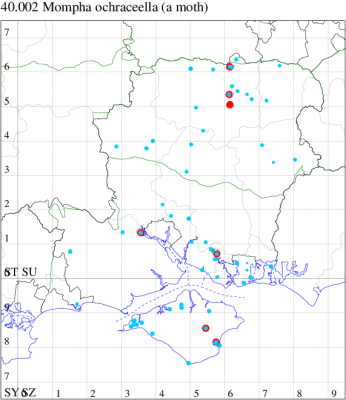
Records by year
Records by week (adult)
Records by week (larval)
Record Details
VC10: Haseley Manor, one, 28 May; Shanklin, six, 24 Jun; one, 25 Jun; one, 06 Jul; one, 30 Jul (IOu);
VC11: Totton, one, 16 May; one, 26 May; one, 09 Jul; one, 11 Jul; two, 17 Jul; one, 20 Jul; two, 30 Jul (LH); Fareham, one, 30 Jun (KJW);
VC12: Harestock, one, to actinic, 14 Jul (GRog); Basingstoke, one, 20 Jun; three, 24 Jun (MJW); one, 31 Jul (RHil); Pamber Forest, one, 25 Jun (GJD)
40.003 [B&F: 0887] Mompha lacteella (Stephens, 1834) - Nationally Scarce B
Nationally scarce (Nb) and confined to woodland and waste ground in parts of England and Scotland. Infrequently recorded in Hampshire, with scattered records across both vice-counties. In the Isle of Wight, reported for the first time in 2016 with two further sightings to 2018, in Shanklin and Parkhurst Forest. Wingspan 9-13 mm. The main confusion species is M. propinquella from which it is distinguished by the beige colour of the head, thorax and basal blotch on the forewing and the dark brownish grey apical area of the forewing (MBGBI Vol 4 part 1). Larva mines leaves of Broad-leaved Willowherb, over-wintering as a small larva.
Update: Status review, December 2019.
Records prior to 2020
| Vice County | #Records | #Individuals | First Record | Last Record |
|---|---|---|---|---|
| 10 | 3 | 4 | 2016 | 2018 |
| 11 | 12 | 13 | 1946 | 2019 |
| 12 | 3 | 3 | 1976 | 2013 |
2020 records
| Vice County | #Records | #Individuals | Max Quantity |
|---|---|---|---|
| 11 | 1 | 1 | 1 |
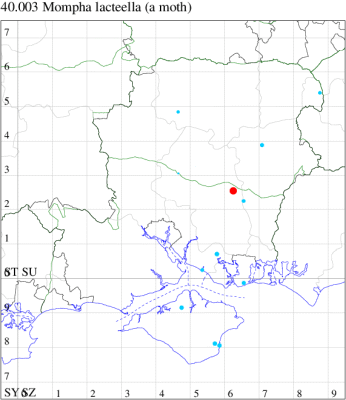
Records by year
Records by week (adult)
Records by week (larval)
Record Details
VC11: West Meon, one, 31 Jul (F.M.G.)
40.004 [B&F: 0888] Mompha propinquella (Stainton, 1851) - Local
Local in open woodland, waste ground and gardens throughout Britain, north to Aberdeenshire. In Hampshire recorded widely in both vice-counties, but there are no recent records from the Isle of Wight. Wingspan 11-12.5 mm. The main confusion species is M. lacteella from which it is distinguished by the white head and thorax and on the forewing by the white basal blotch and brown terminal area (MBGBI Vol 4 part 1). Larva mines leaves of Broad-leaved Willowherb and Great Willowherb, over-wintering as a small larva.
Records prior to 2020
| Vice County | #Records | #Individuals | First Record | Last Record |
|---|---|---|---|---|
| 10 | 3 | 2 | 1900 | 2018 |
| 11 | 157 | 162 | 1975 | 2019 |
| 12 | 148 | 180 | 1990 | 2019 |
2020 records
| Vice County | #Records | #Individuals | Max Quantity |
|---|---|---|---|
| 10 | 1 | 1 | 1 |
| 11 | 13 | 12 | 1 |
| 12 | 9 | 11 | 2 |
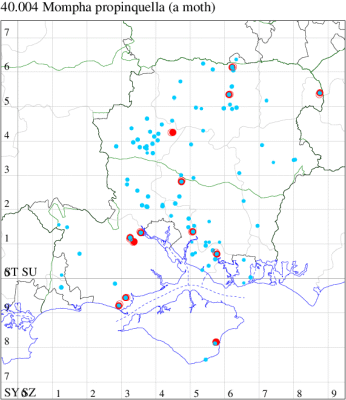
Records by year
Records by week (adult)
Records by week (larval)
Record Details
VC10: Shanklin, one, 09 Aug (IOu);
VC11: Woodlands, New Forest, present, 11 Aug (RBW); Ashurst, NF, one, 07 Aug (SAB); Totton, one, 05 Jul; one, 09 Aug (LH); Eastleigh, one, to actinic, 04 Aug; one, to actinic, 09 Aug; one, to actinic, 11 Aug (KArb); Winchester, one, 07 Aug (THW); Fareham, one, 14 Jun (KJW det. RJD); Botley, one, to actinic, 04 Aug (SLB); Milford on Sea, one, 25 Jun (MMcM); Pennington, one, 27 May; one, 24 Jun (RFC);
VC12: Cholderton*, two, field observation, 11 Aug (TJN, LF); Anna Valley, Andover, one, 30 Jul (TJN); Barton Stacey, one, to actinic, 11 Aug (GCE); Basingstoke, one, 23 Jul (MJW); Pamber Forest, one, 13 Jul; one, 31 Jul (GJD); Farnborough, one, 30 Jul; one, 10 Aug (KBW)
40.005 [B&F: 0889] Mompha divisella Herrich-Schäffer, 1854 - Nationally Scarce A
Nationally scarce (Na) in damp woodland, waste ground, open areas and damp shady places in parts of southern Wales and southern England, with records north to Cumbria. In our area it was for a long time restricted to the area of vice-county 11 around Christchurch in Dorset, but in recent years - whether through increased observer interest or genuine increase in range - has spread to a number of localities along the south coast. There is one isolated record in the north of Hampshire. First recorded on the Isle of Wight at Freshwater in 2011, where it is now annual. Wingspan 10-13 mm. Superficially similar to M. bradleyi, but white dorsal streak at base of forewing less strongly irrorate with darker scales and thorax light brown with only anterior edge dark greyish brown (MBGBI Vol 4 part 1). Larva mines stems of Broad-leaved Willowherb, Marsh Willowherb and Hoary Willowherb, forming galls.
Records prior to 2020
| Vice County | #Records | #Individuals | First Record | Last Record |
|---|---|---|---|---|
| 10 | 12 | 11 | 1959 | 2018 |
| 11 | 65 | 70 | 1932 | 2019 |
| 12 | 8 | 7 | 1946 | 2019 |
2020 records
| Vice County | #Records | #Individuals | Max Quantity |
|---|---|---|---|
| 11 | 20 | 19 | 1 |
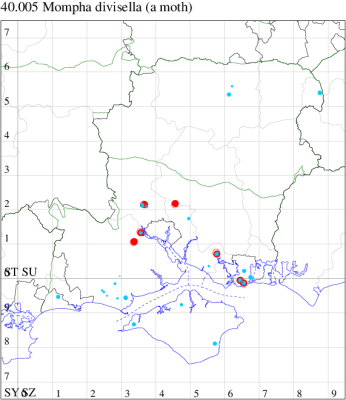
Records by year
Records by week (adult)
Records by week (larval)
Record Details
VC11: Ashurst, NF, one, 03 Apr; present, 04 Apr (SAB); Totton, one, 01 Apr; one, 03 Apr; one, 09 Apr; one, 11 Apr; one, field observation, 23 Apr; one, field observation, 15 May; one, 05 Sep (LH); Romsey, one, 07 Apr (SLay); Eastleigh*, one, to actinic, 07 Apr; one, to actinic, 08 May (KArb); Allbrook*, one, 14 Sep (SI); Fareham, one, gen det, 01 Apr; one, indoors, ♂, gen det, 01 Apr; one, seen by day, ♀, gen det, 07 Sep (KJW det. RJD); Southsea, one, 07 Apr; one, 02 May (JGe); one, 05 Apr; one, ♂, gen det, 15 May (JRL)
40.006 [B&F: 0890] Mompha jurassicella (Frey, 1881) - Nationally Scarce A
Nationally scarce (Na) on waste ground and in dry open areas in south-eastern England, north to Yorkshire. In Hampshire apparently restricted to a few locations near Fareham. Not recorded from the Isle of Wight to date. Wingspan 11-14 mm. Most likely to be confused with M. bradleyi and M. divisella, but forewing a more uniform brownish grey colour. Larva mines stems of Great Willowherb, forming galls.
Records prior to 2020
| Vice County | #Records | #Individuals | First Record | Last Record |
|---|---|---|---|---|
| 11 | 255 | 877 | 1995 | 2019 |
2020 records
| Vice County | #Records | #Individuals | Max Quantity |
|---|---|---|---|
| 11 | 28 | 91 | 19 |
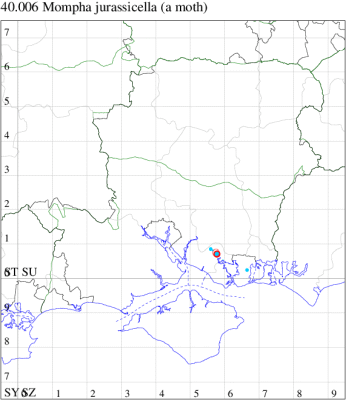
Records by year
Records by week (adult)
Records by week (larval)
Record Details
VC11: Fareham, one, 02 Feb; two, field observation, 05 Feb; three, field observation, 17 Feb; four, field observation, 22 Feb; three, field observation, 23 Feb; three, field observation, 27 Feb; three, field observation, 01 Mar; 13, field observation, 03 Mar; three, field observation, 05 Mar; one, field observation, 07 Mar; two, field observation, 11 Mar; six, field observation, 13 Mar; six, field observation, 14 Mar; 19, field observation, 21 Mar; one, field observation, 26 Mar; two, field observation, 28 Mar; one, field observation, 29 Mar; one, indoors, 30 Mar; one, field observation, 01 Apr; five, field observation, 02 Apr; one, field observation, 03 Apr; one, field observation, 04 Apr; two, field observation, 07 Apr; one, field observation, 09 Apr; one, field observation, 12 Apr; two, field observation, 18 Apr; two, field observation, 22 Apr; one, field observation, 23 Apr (KJW)
40.007 [B&F: 0889a] Mompha bradleyi Riedl, 1965 - Nationally Scarce B
Nationally scarce (Nb) in damp meadows, ditches and marshes in Herefordshire and Worcestershire. In Hampshire recorded for the first time at Fareham on 4 September 2010 and now not infrequent in the Portsmouth area. A healthy population was subsequently discovered in the author's garden in Basingstoke, north Hampshire, where the foodplant is common, so it may be more widespread than currently known. Reported new for the Isle of Wight in 2022. Wingspan 9-11 mm. Long confused with and closely resembling M. divisella, but generally smaller, with broader forewing and white dorsal streak at base of forewing more strongly irrorate with grey and brown scales (MBGBI Vol 4 part 1). Larva mines stems of Great Willowherb, forming galls.
Records prior to 2020
| Vice County | #Records | #Individuals | First Record | Last Record |
|---|---|---|---|---|
| 11 | 12 | 17 | 2010 | 2014 |
| 12 | 13 | 27 | 2011 | 2015 |
2020 records
| Vice County | #Records | #Individuals | Max Quantity |
|---|---|---|---|
| 11 | 2 | 2 | 1 |
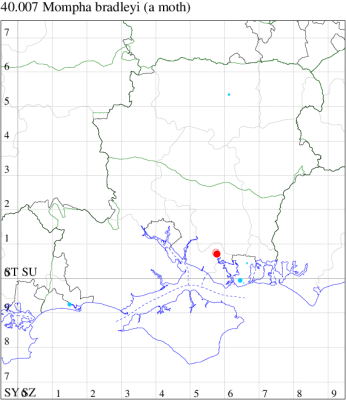
Records by year
Records by week (adult)
Records by week (larval)
Record Details
VC11: Fareham, one, indoors, ♀, gen det, 26 Mar; one, indoors, ♀, gen det, 29 Mar (KJW det. RJD)
40.008 [B&F: 0892] Mompha subbistrigella (Haworth, 1828) - Common
Common in freshwater margins, ditches, woodland clearings, waste ground and gardens across much of England and Wales, less numerous in the north. In Hampshire relatively common in the north-east and south-east, but apparently absent from much of the New Forest and the Isle of Wight. Wingspan 7-11.5 mm. The main confusion species is M. sturnipennella, from which it can be distinguished by its smaller size and by the broader forewing which lacks the median ferruginous streaks and the white costal streaks in the apical area (MBGBI Vol 4 part 1). Larva feeds within seedpods of Broad-leaved Willowherb, Marsh Willowherb and Hoary Willowherb.
Records prior to 2020
| Vice County | #Records | #Individuals | First Record | Last Record |
|---|---|---|---|---|
| 10 | 86 | 116 | 1995 | 2019 |
| 11 | 1032 | 1436 | 1975 | 2019 |
| 12 | 352 | 536 | 1995 | 2019 |
2020 records
| Vice County | #Records | #Individuals | Max Quantity |
|---|---|---|---|
| 10 | 9 | 10 | 2 |
| 11 | 68 | 94 | 5 |
| 12 | 32 | 46 | 3 |
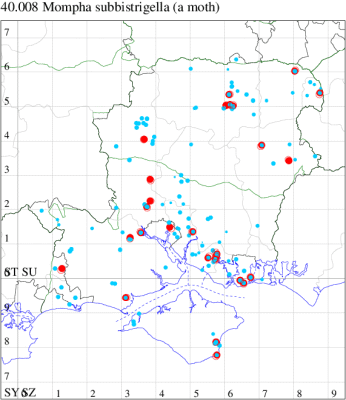
Records by year
Records by week (adult)
Records by week (larval)
Record Summary
VC10: Earliest: Bonchurch, 02 Apr, 1 (JHa) Latest: Shanklin, 17 Jul, 1 (IOu) Max count: Shanklin, 25 Jun, 2 (IOu)
VC11: Earliest: Brockwood, 30 Jul, 1 (SDut) Latest: Southsea, 02 Jun, 0 (JRL) Max count: Totton, 31 May, 5 (LH)
VC12: Earliest: Anna Valley, Andover, 02 Jun, 3 (TJN) Latest: Yateley, 08 Jun, 2 (JHH) Max count: Anna Valley, Andover, 02 Jun, 3 (TJN)
40.010 [B&F: 0893] Mompha epilobiella ([Denis & Schiffermüller], 1775) - Common
Common at freshwater margins and on dry open areas and waste ground throughout England and Wales, less numerous in the north, rare in southern Scotland and Ireland. In Hampshire and on the Isle of Wight only frequent in south-east Hampshire, but perhaps under-recorded elsewhere. Wingspan 10-13 mm. When worn it can be distinguished from similar specimens of M. ochraceella by its grey hindwings and smaller wingspan (MBGBI Vol 4 part 1). Larva feeds on Great Willowherb.
Records prior to 2020
| Vice County | #Records | #Individuals | First Record | Last Record |
|---|---|---|---|---|
| 10 | 159 | 245 | 1850 | 2019 |
| 11 | 659 | 795 | 1975 | 2019 |
| 12 | 78 | 81 | 1981 | 2019 |
2020 records
| Vice County | #Records | #Individuals | Max Quantity |
|---|---|---|---|
| 10 | 11 | 16 | 4 |
| 11 | 32 | 30 | 2 |
| 12 | 2 | 2 | 1 |
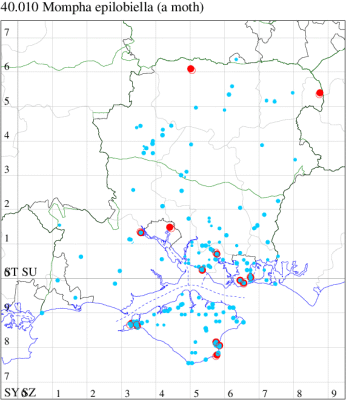
Records by year
Records by week (adult)
Records by week (larval)
Record Details
VC10: Totland, two, field observation, 19 Sep; four, 20 Sep (RTe); Afton Marsh, one, field observation, emerged from pupa, 30 Aug (SDa); Bonchurch, one, 21 May; one, 27 May (JHa); Shanklin, one, ♂, gen det, 10 Apr; two, 25 Jun; one, 22 Jul; one, 14 Aug; Shanklin Upper Chine, one, 14 Sep (IOu);
VC11: Totton, one, field observation, 09 May; one, field observation, 10 Jul; one, 10 Jul; one, 23 Jul (LH); Southampton, one, to actinic, 24 Jun (MGP det. MJW); Titchfield Haven NNR, one, 17 Jul (F.M.G.); Fareham, one, field observation, 11 Mar; one, field observation, 18 Mar; one, field observation, 03 Apr; one, field observation, 07 Apr; one, field observation, 09 Apr; one, field observation, 10 Apr; one, field observation, 12 Apr; one, field observation, 18 Apr; one, field observation, 22 Apr (KJW); Portsmouth, one, 15 Jun; one, 24 Jun; two, 25 Jun; one, 08 Jul; one, 16 Jul; one, 18 Jul; one, 22 Jul; one, 23 Jul; one, 12 Aug (IRT); Southsea, one, 03 Jul (JGe); one, 09 Apr; one, 27 Apr (JRL);
VC12: Ecchinswell*, one, indoors, 16 Nov (MJN); Farnborough*, one, 23 Apr (KBW)
40.011 [B&F: 0880] Mompha langiella (Hübner, 1796) - Local
Local in woodland in parts of England and Wales, more numerous in the west, rare elsewhere. In the south of Hampshire the mines of this species are often locally abundant, but until a specimen was bred by Rob Edmunds in Fleet in 2003 it had not been recorded in vice-county 12, and on the Isle of Wight first recorded in 2009 at Combley Great Wood. The photo shows one bred in 2004, again by Rob. Wingspan 9-10.5 mm. Larva mines leaves of Enchanter's-nightshade and Great Willowherb.
Records prior to 2020
| Vice County | #Records | #Individuals | First Record | Last Record |
|---|---|---|---|---|
| 10 | 11 | 26 | 2009 | 2019 |
| 11 | 27 | 217 | 1988 | 2019 |
| 12 | 7 | 3 | 2003 | 2019 |
2020 records
| Vice County | #Records | #Individuals | Max Quantity |
|---|---|---|---|
| 11 | 1 | 0 | 0 |
| 12 | 1 | 0 | 0 |
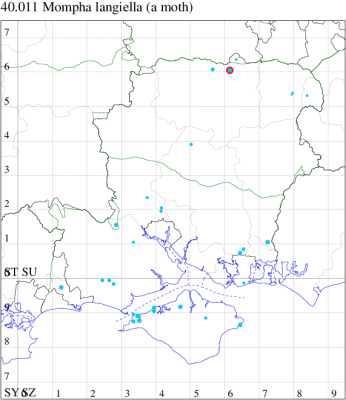
Records by year
Records by week (adult)
Records by week (larval)
Record Details
VC11: Chandlers Ford, present, bred, many from Epilobium, 01 Jul (BE);
VC12: Pamber Forest, vacated mine, present, many on streamside enchanter's nightshade, 08 Jun (GJD)
40.013 [B&F: 0882] Mompha locupletella ([Denis & Schiffermüller], 1775) - Local
Local in damp areas throughout the British Isles. In Hampshire and on the Isle of Wight scarce and barely annual in scattered localities, mostly in south-east Hampshire. Wingspan 9-12 mm. Could be confused with M. terminella, but larger and brighter, and with cilia unicolorous. Larva mines leaves of various species of Willowherb.
Records prior to 2020
| Vice County | #Records | #Individuals | First Record | Last Record |
|---|---|---|---|---|
| 10 | 7 | 4 | 1900 | 2000 |
| 11 | 17 | 19 | 1972 | 2016 |
| 12 | 3 | 2 | 1974 | 2016 |
2020 records
| Vice County | #Records | #Individuals | Max Quantity |
|---|---|---|---|
| 11 | 1 | 1 | 1 |
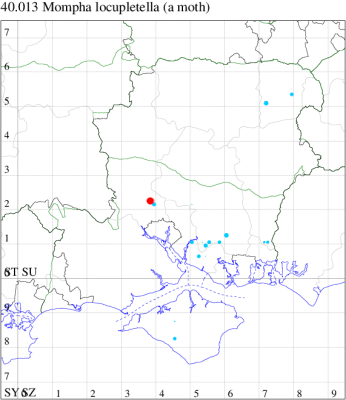
Records by year
Records by week (adult)
Records by week (larval)
Record Details
VC11: Romsey, one, 22 Sep (NRJ det. MJW)
40.014 [B&F: 0881] Mompha terminella (Humphreys & Westwood, 1845) - Nationally Scarce B
Nationally scarce (Nb) in shady woodland throughout much of England and Wales. Widely distributed across Hampshire and on the Isle of Wight, but very infrequently recorded and probably absent from much of north-east Hampshire. Wingspan 7-9 mm. Could be confused with M. locupletella, but smaller and darker, and with cilia pale dorsally. Larva mines leaves of Enchanter's-nightshade, over-wintering as a pupa.
Records prior to 2020
| Vice County | #Records | #Individuals | First Record | Last Record |
|---|---|---|---|---|
| 10 | 11 | 2 | 1900 | 2017 |
| 11 | 18 | 46 | 1988 | 2012 |
| 12 | 5 | 3 | 1981 | 2005 |
2020 records
| Vice County | #Records | #Individuals | Max Quantity |
|---|---|---|---|
| 10 | 2 | 1 | 1 |
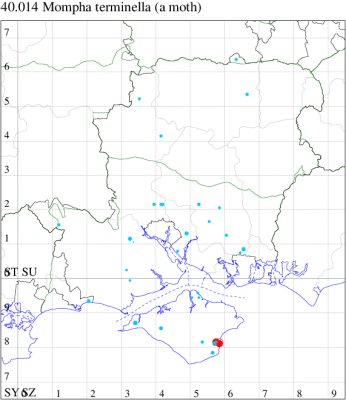
Records by year
Records by week (adult)
Records by week (larval)
Record Details
VC10: Shanklin, one, 07 Oct (IOu); Shanklin Chine, mine, present, several mines on leaves of Circaea lutetiana, 27 Sep (PBa)
40.015 [B&F: 0883] Mompha raschkiella (Zeller, 1839) - Common
Common on heathland, waste ground, roadside verges and woodland clearings throughout the British Isles. Rather common and widely distributed on the Isle of Wight and in southern Hampshire, but decidedly scarce in the north of the county. Wingspan 7-11 mm. Could be confused with M. locupletella, but lacks that species contrasting dark and light patches at base of forewing. Larva mines leaves of Rosebay Willowherb, over-wintering as a pupa.
Records prior to 2020
| Vice County | #Records | #Individuals | First Record | Last Record |
|---|---|---|---|---|
| 10 | 80 | 28 | 1978 | 2018 |
| 11 | 81 | 104 | 1973 | 2019 |
| 12 | 48 | 22 | 1984 | 2018 |
2020 records
| Vice County | #Records | #Individuals | Max Quantity |
|---|---|---|---|
| 10 | 2 | 1 | 1 |
| 11 | 1 | 1 | 1 |
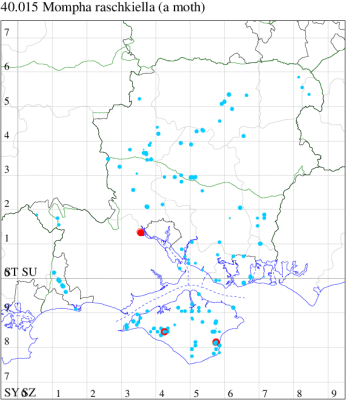
Records by year
Records by week (adult)
Records by week (larval)
Record Details
VC10: Brighstone Forest, mine, present, mines in leaves of Chamerion angustifolium, 20 Sep (PBa); Shanklin, one, gen det, 30 Jul (IOu);
VC11: Totton*, one, 31 Jul (LH)